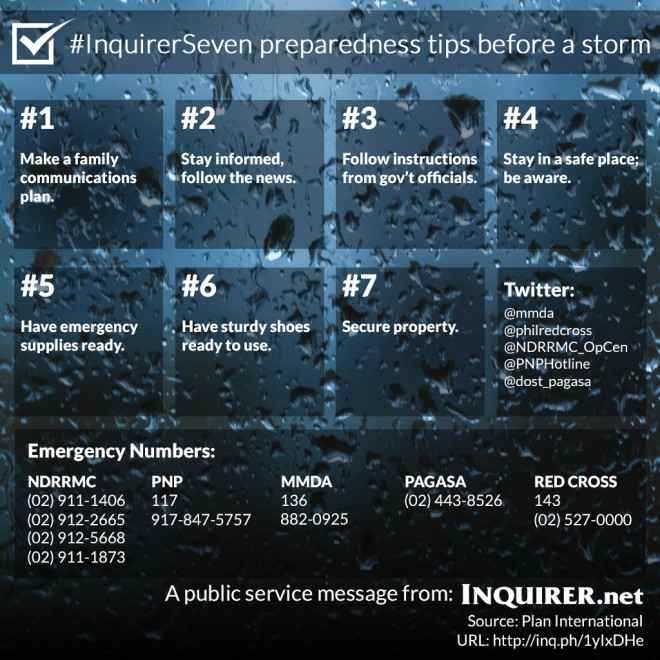Tips, reminders on how to survive typhoons before, during, after
 Here are very practical tips and timely reminders to prepare for a storm from Plan International, Philippine Red Cross and the Official Gazette:
Here are very practical tips and timely reminders to prepare for a storm from Plan International, Philippine Red Cross and the Official Gazette:
Before
- Be updated with the latest weather reports.
As an incoming weather disturbance is approaching the country, it is important to always keep yourself updated with the latest weather reports. Staying informed with the latest weather bulletins and following government announcements and warnings are the best starting points to prepare yourself and your families for the storm.
- Make communication plans.
Make a family communication plans so that you can establish the whereabouts of all family members (and keep mobile phones charged!). Stay in contact but have a plan in case cell phone coverage disappears during the storm; like a predestined meet-up place where you can find each other once it is safe to go out again.
It is important to ready a list of emergency hotlines to call too.
NDRRMC: (02) 911-1406, 912-2665, 912-5668, 911-1873
PNP: 117 or TXT PNP to 2920, 0917-847-5757
BFP: 117, (02) 729-5166, 410-6319
DOTC: 7890, (02) 726-6255
MMDA: 136, 882-0860, 882-3983, (02) 882-4154 to 74 loc. 337
Pagasa: (02) 927,-9308, 434-2696
DSWD: (632) 931-8101 to 07 loc. 426, (02) 951-7119
Red Cross: 143, (02) 527-0000, (02) 527-8385 to 95
Phivolcs: (02) 426-1468 to 79 loc. 124/125, 0905-3134077
In the Visayas, the emergency hotline numbers are as follows:
Cebu City’s Command Control Center: 166, (032) 262-1424, 0923-524-8222, 0932-537-7770, 0947-178-0000, 0947- 178-9999
Tacloban RDRRMC: 0915-762-2368, 0917-855-3868, 0915-184-0918
Tacloban CDRRMC: 0917-322-9585, 0917-315-8356
Samar PDRRMC: (055) 251-3413, 0927-337-2702
Calbayog CDRRMC: (055) 209-3993, 0917-7222689
Western Visayas RDRRMC: (033) 509-7919, 337-6671
- Prepare supplies and disaster gear.
Have emergency supplies ready and have them ready to carry out in a small backpack so you can have your hands free. These should include some nonperishable food, water or water purification tablets or drops, first aid kit, flashlights and extra batteries. If safe drinking water is not available, boil water for at least 20 minutes. Place it in a container with cover.
Don’t forget some basic toiletries and some disinfectant to keep yourself clean.
Have sturdy shoes ready to use when you have to evacuate. Don’t forget to seal important family documents in plastic and carry them with you if you have to evacuate.
Make sure you have a small battery operated radio to be updated with the news because it is highly possible that there will be a power outage during and after the storm. Bring it with you if you have to evacuate.
- Protect property.
Secure your property before a storm hits by trimming trees, securing roofs and covering windows.
Examine your house and repair its unstable parts. Harvest crops that can be yielded already. Secure domesticated animals in a safe place.
- Obey evacuation orders.
Follow instructions from government officials on preemptive evacuation at all times. Move away from low-lying areas and stay away from the coasts and riverbanks.
Evacuate calmly and as soon as possible. Do not wait for your situation to worsen before evacuating. Close the windows and turn off the main power switch of your house. Put important appliances and belongings in a high ground.
When evacuating, avoid the way leading to the river. For fisher folks, place boats in a safe area.
During
- Secure yourselves.
Stay in a safe place. It is important to be aware which areas are prone to floods, landslides etc. and which buildings are safe enough to withstand a typhoon. Do not go outside during the storm.
In case of a threat of a storm surge, evacuate in a high place early. If possible, find a place that is higher than 500 meters from the bay if your community is in the direct track of the storm.
After
- Continue to be alert.
Do not wade through floodwaters to avoid being electrocuted and contracting diseases. If your house is destroyed, make sure that it is stable before you enter. Watch out for live wires or outlet immersed in water. Report damaged electrical cables and fallen electric posts to the authorities.
Avoid going to disaster-hit areas so as not to get in the way of rescue and emergency operations.














